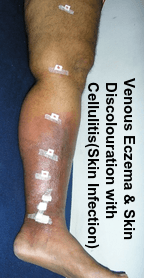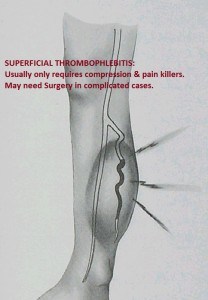Complications of Varicose Veins
How do varicose veins present
1. Cosmetic problems – they look bad but don’t feel bad.
2. Localized discomfort – in the leg, especially after standing. Usually at the site of a visible varicose vein.
3. Generalized discomfort – aching and discomfort particularly at the end of the day.
4. Night cramps.
5. Acute bleeding – this can be alarming and even life threatening. It is treated by putting the leg in the air and applying pressure.
6. Thrombophlebitis – an inflammatory condition in which a portion of a varicose vein becomes red and painful.
7. Discoloration. The varicose veins contain blood, which is made up in part of iron. The iron pigment can lead to a temporary/permanent brownish discoloration of the skin. This will usually decrease over time but can take weeks to months in severe cases. Most patients state that they are much happier with the color than they were with the veins appearance and over time the discoloration is much better.
Complications After Surgery
8. Damage to major arteries or veins. This should not occur when the procedure is done by an experienced vascular surgeon.
9. Development of the thread veins can occur after venous surgery. These can be easily treated with sclerotherapy if needed.
10. Deep vein thrombosis. This is rare in healthy patients having uncomplicated varicose vein surgery.
If varicose veins are due to damage to the deep veins, then they may cause itching, brown discoloration round the ankle, swelling of the leg and large ulcers. The latter may last for years and be very resistant to treatment.
Venous Ulcers, Venous Eczema, Venous Skin Ulcers: When the venous system in the leg fails to work normally the pressure in the leg veins rises. This reduces the circulation in the lower leg particularly around the ankle leading to swelling, discomfort, skin changes (VARICOSE ULCERS/SKIN ULCERS/STASIS DERMATITIS) and eventually ulceration. Varicose veins are the commonest cause for this.
Venous Eczema & Skin Changes: A form of eczema can occur in the calf, sometimes over an area of varicosity. The skin is red and itchy. Areas of the calf and around the ankle may develop a brown stain in the skin. The ankle area may be prone to swelling towards the end of the day. Sometimes the entire lower leg feels tight and hard, and may look red and inflamed. This may be acute lipodermatosclerosis (LDS) due to the high venous pressure or an infection (cellulitis). Treatment of the underlying venous disease leads to resloution of the eczema and the gravitational/stasis dermatitis if it is the only cause of the eczema. The treatment of this eczema is not steroid creams, which must be strictly avoided till a venous cause has been excluded by a surgeon experienced in treating these conditions.
Venous Ulcers: There are many theories to explain why the raised pressure in abnormal leg veins leads to skin problems like stasis dermatitis & skin ulcers. The skin becomes vulnerable, and is poor at healing. A small injury, bite, or minor infection, which would normally heal, instead progresses, and an area of skin breakdown results. This is called an ulcer. In the presence of venous disease, the term Venous Ulcer is used.


